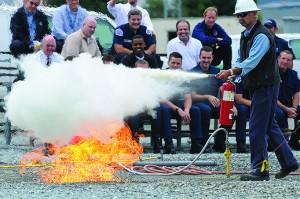
On an average day, over 200 fires occur in U.S workplaces, costing American businesses over $2 billion on an annual basis. According to the Occupational Safety & Health Administration:
Where the employer has provided portable fire extinguishers for employee use in the workplace, the employer shall also provide fire safety training for employees focusing on the general principles of fire extinguisher use and the hazards involved with incipient stage firefighting.
To break down this requirement, we’ve analyzed a few frequently asked questions and points of clarification.
What is the purpose of the training?
OSHA requires that workers be trained not only to recognize when to use a portable fire extinguisher, but also how to correctly operate the fire extinguisher.
Are there any exemptions?
- When the employer has established and implemented a written fire-safety policy requirement for the immediate evacuation of all employees.
- When the company has an emergency-action plan that designates only certain employees to use the available fire extinguisher.
What does the training cover?
The employer is required to provide an educational program to familiarize employees with the general principles of fire extinguisher use and the hazards involved with incipient stage firefighting.
How does the training tackle the different types of fire extinguishers?
Prior to training we will survey the facility (if we are not already familiar with it) to see the types of extinguishers they have. During the training we will talk about what specifically is in there building. If the training is a live fire and the customer wants to use something more than the standard ABC/BC units – we can use different types of fire extinguishers to demonstrate them to the customer (with the exception of certain clean agents). During the classroom presentation all the different classes of fire are covered and the different extinguishers that can be effective on these classes. We also talk about what not to use, for example, a pressurized water unit on an energized electrical fire.
What other resources are available for fire extinguisher training?
One simple resource is the owner’s manual that comes with every new unit.
They typically talk about the classes of fire and what types of extinguishers should be used on them. There are several types of fire training – the Ansul simulator, the Bullex unit, and of course a live burn. These resources allow the training to be conducted inside or outside depending on the local requirements and the customer preference.
How long is the certification good for?
The certification should be done on an annual basis for a commercial business.
Does the training also cover general fire extinguisher safety?
One of the biggest benefits to fire extinguisher training is that people have some type of extinguishers in their home. During the training we tell people outside of work what to look for in a reliable unit for home protection. A lot of our branches also offer to our customers that they can bring their units in from home during the training if they would like our guys to take a look at them while we are there. There are no inspection regulations for home units (unless you have a business in your home) so people often don’t think about the condition of their fire extinguishers until they need to use them.
Is your company in need of fire extinguisher training? Koorsen Fire & Security has three fire extinguisher training programs, each designed to meet the unique needs of our customers and keep them up to code with OSHA requirements.
To find out more about our fire extinguisher training options, contact us online today.

